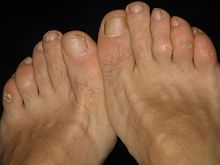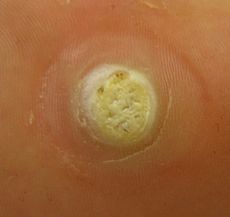- 7 Days to Super Star Feet
- Toe-Nailed It!
- Cotton is Rotton
- Oh My Aching Feet! (Bunions, Corns, and Plantar Warts)
- A Serious Pain in the Foot: Plantar Fasciitis
- Let the Good Feet Roll! Overpronator or Supinator?
- Finding the Right Shoe for YOU

7 Days to Super Star Feet
Oh My Aching Feet! (Bunions, Corns, and Plantar Warts)
by Coach Jill Csillag
These three conditions that affect the feet are not only very common, but also can be quite painful. As a lucky person who has suffered from all three conditions, let me assure you they all can be quite unpleasant.
Let’s get down to the nitty-gritty of each of these conditions:
Bunions
A bunion is a bony bump that forms on the joint at the base of your big toe. A bunion forms when your big toe pushes against your next toe, forcing the joint of your big toe to get bigger and stick out. The skin over the bunion might be red and sore. (Take it from me, this is true). It can be quite a challenge to find shoes that are comfortable when you suffer from a bunion.

Photo of a bunion. Ouch! (Photo credit: https://en.wikipedia.org/wiki/Bunion)
There are several causes for the dreaded bunion, which include but are not limited to:
- Wearing tight-fitting, narrow shoes
- Heredity
- Foot injuries
- Congenital birth defects
- Certain types of arthritis, specifically inflammatory arthritis, such as rheumatoid arthritis
What can you do for a bunion?
Once a bunion presents itself, there are a few things you can do to lessen your pain. Find shoes that are not only comfortable but also wide enough to avoid further irritation on the bunion area.
Toe spacers & bunion stretchers can help to ease the pain of a bunion by encouraging the big toe to return back to it’s normal placement, but this takes time and doesn’t work for everyone.
Moleskin and adhesive pads can be applied to the bunion area to prevent irritation from rubbing inside the shoe.
Icing the afflicted area can help to minimize pain.
Surgery may be indicated in severe cases, but can take weeks to months to recover from. Surgery isn’t recommended unless a bunion causes you frequent pain or interferes with your daily activities.
An ounce of prevention is worth a pound of cure when it comes to a bunion. Limit your time in narrow shoes with pointy toes if you can and change your shoes often. Shoe inserts may also help to stabilize the foot within a shoe to minimize discomfort and the chance of your bunion getting any worse.
Corns
There are several different types of corns.

Corns. More ouch! (Photo credit: https://en.wikipedia.org/wiki/Callus)
A hard corn is a small patch of thickened, dead skin with a central core. A soft corn has a much thinner surface and usually occurs between the 4th and 5th toes. Corns generally occur on the tops and sides of the feet.
A seed corn is a tiny, discrete callous that can be very tender if it’s on a weight-bearing part of the foot. Seed corns tend to occur on the bottom of the feet, and some doctors believe this condition is caused by plugged sweat ducts. As a seed corn sufferer, I can attest that it can be very painful when you put weight down on your bare foot. OUCH!
Just like the bunion, corns can make their appearance after wearing ill-fitting shoes, especially the high-heeled variety. Being a sufferer of foot deformities also makes you more susceptible to developing corns, as well as wearing sandals or shoes without socks.
Treatment for corns
You can apply medicated corn pads to treat the corn, and usually these treatments contain a percentage of salicylic acid to slowly dissolve the corn. This process is often very slow.
Oftentimes a podiatrist will trim away the dead skin or the top of the corn with a scalpel to get to the root of the problem. This should only be done by a podiatrist or medical professional to avoid injury and infection.
Shoe inserts may also be indicated, especially if the cause of the corn is due to a foot deformity.
Plantar Warts
What is the difference between a plantar wart and a corn? They both can be similar not only in cause, but treatment as well. Seed corns most closely resemble a plantar wart, which occur mainly on the bottom of the foot.

Large Plantar Wart (Photo source: https://en.wikipedia.org/wiki/Plantar_wart)
Plantar warts are hard, grainy growths that usually appear on the heels or balls of your feet, areas that feel the most pressure. This pressure also may cause plantar warts to grow inward beneath a hard, thick layer of skin.
Surprising to some folks, plantar warts are caused by the human papillomavirus (HPV).
The telltale symptoms of a plantar wart include:
- Small, fleshy, rough, grainy growth on the bottom of your foot
- Hard, thickened skin over a well-defined “spot” on the skin, where a wart has grown inward
- Black pinpoints, which are commonly called wart seeds but are actually small, clotted blood vessels
- Pain or tenderness when weight is placed upon the foot
Like corns, most plantar warts can be treated at home, but require patience. Over the counter freezing kits can be highly effective, but oftentimes treatments need to be repeated multiple times. Salicylic acid can also be used to treat the wart, but again, this is a time-consuming process.
There are some theories that applying duct tape over the wart, replacing after every shower, works to slough off the layers of the wart, thereby ultimately allowing access to the “seed” or core of the wart. I can attest, from personal experience, that this method does indeed work! You just have to be patient, and be prepared to use a lot of duct tape before all is said and done!
In conclusion, these three maladies are some of the most common conditions that you may or may not experience in your lifetime. If you are the latter, consider yourself very lucky!
Thankfully, there are several over the counter treatments that offer some relief and resolutions of symptoms. The most important thing to remember is to BE PATIENT.
Treat your feet with a little TLC and they will thank you each and every day with optimum health!
Tomorrow: The Pain of Plantar Fasciitis
Have a question for Coach Jill? Ask it in the comments below!
Also check out these posts: A Guide to Finding the Best Athletic Footwear for You, Common Foot Injuries and How to Treat Them, 100 lb Weight Loss: How Did You DO It?
Coach Jill’s Favorite Recommended Super Feet Resources:













Leave a Reply